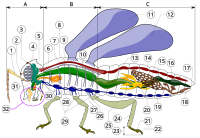
Photo from wikipedia
ObjectivesThis study aims to investigate the root canal morphology of permanent mandibular second molars of an Indian population in vivo using cone-beam computed tomography (CBCT) images.MethodsCBCT images (n = 983; males = 489, females = 494)… Click to show full abstract
ObjectivesThis study aims to investigate the root canal morphology of permanent mandibular second molars of an Indian population in vivo using cone-beam computed tomography (CBCT) images.MethodsCBCT images (n = 983; males = 489, females = 494) of untreated, completely developed permanent mandibular second molar teeth were examined. CBCT scans were acquired as part of diagnosis and treatment planning for treatments unrelated to the present study. The number of roots and root canals were recorded. Canal configuration was classified based on Vertucci’s and Fan’s classifications.ResultsThe most common configuration was two-root (79.35%) and three-root canals (53.50%). The incidence of three-rooted molars was 7.53%, whereas 13.12% of the studied teeth studied have fused roots with C-shaped canals. The predominant canal morphology in the mesial roots was Vertucci’s type IV (45.17%), followed by type II (32.55%), type I (7.23%), type V (1.02%), and type III (0.91%). The distal root in contrast showed type I (61.14%) as the predominant canal configuration, followed by type II (18.21%) and type IV (7.53%). The incidence of three-rooted molars was higher in males (n = 55; 5.59%) than in females (n = 19; 1.94%) (p < 0.01). The canals in the extra roots exhibited type I (100%) root canal morphology. In teeth with C-shaped root canal (13.12%), the variations in the coronal, middle, and apical third ranged from C1 to C4.ConclusionsRoot canal systems of the mesial roots of mandibular second molars of the study population demonstrated a high degree of variability. While three roots were rare, there was a sexual predisposition. Fused roots with C-shaped canals were rare and demonstrated significant variations from the coronal to apical third.Clinical relevanceRoot canal morphology can demonstrate variations based on race and sex of patients. Clinicians must always consider the possible variations to ensure successful endodontic treatment.
Journal Title: Clinical Oral Investigations
Year Published: 2017
Link to full text (if available)
Share on Social Media: Sign Up to like & get
recommendations!